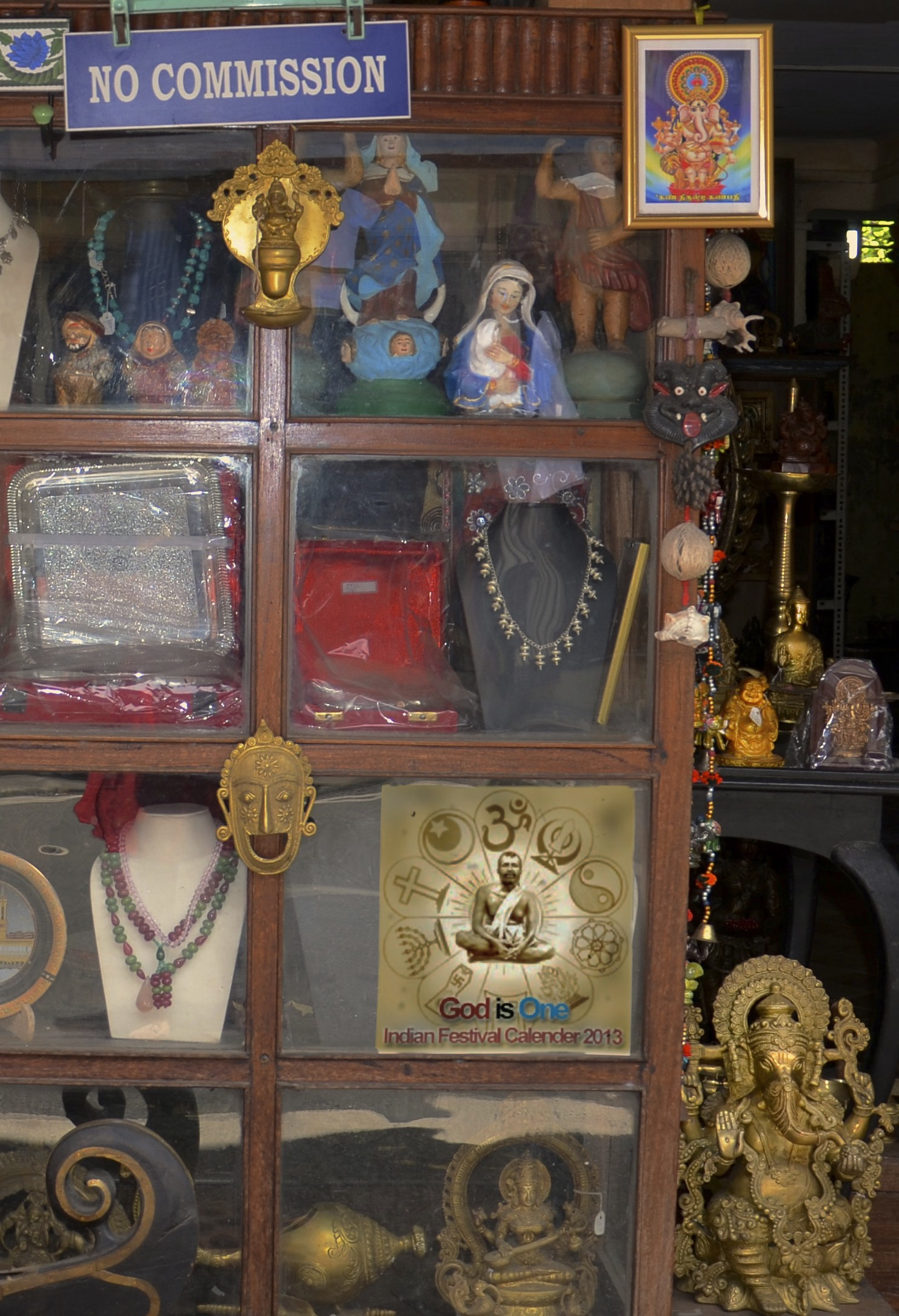Les ateliers du quinquennal 2014-2018 |
Religious Plurality and Reflexivity in South Asia
Coordinators: Aminah Mohammad-Arif and Grégoire Schlemmer
South Asia is known for its high level of religious plurality: Hinduism, Islam, Christianity, Sikhism, Buddhism, Zoroastrianism, Jainism, Judaism and tribal religions, an array of traditions, each one of which is in turn characterized by important internal variations, have existed alongside each other for centuries. In such a context, how can we conceptualize the forms of interaction between members of these religions? How is this plurality experienced on a concrete level? What impact does this coexistence have on the representations and practices of individuals? What are the possible points of contact, but also of divergence between them? At a time of crisis in Europe, with a debate about religious plurality emerging, the multidenominational nature of South Asian societies may serve as a field of reflection with even greater heuristic value when we consider that the contemporary trend of hardening religious lines and identity politics makes this issue a particularly pertinent one.
Of course, significant work on this theme has already been done. There are some very rich studies on particular religions (Ahmad & Reifeld 2004, Mayaram 1997 for Islam and Hinduism, Mumford 1989 for Buddhism and local religions, etc.), or studies that approach religious plurality from specific angles, like the question of identity politics, in particular based on the case of Christians and Muslims in India (Assayag & Tarabout 1997), or the question of institutions and/or politics, with secularism as an entry point for example (Jaffrelot & Mohammad-Arif 2012).
What we propose to do here is approach religious plurality differently, taking individuals—and their own conceptions and practices—as our starting point. By individual, we do not necessarily mean an autonomous actor completely unconstrained by collective logics and able to freely choose his own convictions, as is suggested by the modern notion of individualism. But we would like to do something similar to what has been done in subaltern studies, which have reinstated the groups studied as political subjects and agents of their own history, and foreground the role of agency in the less studied area of religion.
To do so, we will emphasize the concept of reflexivity—that intellectual activity in which thought turns back upon itself, inserting distance between the subject and its conceptions and practices, thus creating a space for reflection, evaluation, even doubt and questioning. We will start out with the hypothesis that what most fosters the reflexive process is interaction with other forms of religious practice and discourse on religion: by revealing several different possible choices, these forms of interaction call into question the potentially routine and unthought aspect of religious practices and representations for the individuals concerned. We also assert that this reflexive process in turn has effects on the religious conceptions and practices of the individuals concerned, as well as on the way in which they conceive of the practices and representations of individuals belonging to these other religions which they come in contact with. Taking their experience of religious diversity and the reflexive process that it generates as a point of departure (through observations, narratives, life stories), we will therefore be interested in the way in which particular individuals re-think, adapt, re-interpret their religious conceptions and practices through the lens of the other. In the end, our aim will be to study the experience of religious plurality based on the reflexive discourses of individuals who experience it, with the hypothesis that these discourses can have effects on the conceptions and practices of the individuals concerned and on their conceptions and practices regarding others.
This research group will be based on case studies describing situations and processes, either past or present, of experiences of religious plurality among different South Asian societies. The case-study approach is made necessary by the importance of the contexts—historical, political, legal, social and of course religious—that shape the way in which religious plurality is thought and experienced by the individuals. Beyond this wide variety of contexts, the processes at work will be approached through the analysis of three situation types in which religious plurality occurs: coexistence, interpenetration, conversion.
Situations of coexistence. By coexistence, we mean situations in which individuals or groups belonging to different religions live alongside each other, while remaining clearly distinct. These situations can be analyzed in different contexts and at several levels (spatial, temporal, social milieus, etc.). We will study the particulars of the negotiation, accommodation, demarcation and affirmation of religion, or of conflict should it arise, between individuals or communities of different religious denominations. We will also analyze the level of mutual knowledge (on the basis of discourse on the commonalities and differences between the groups, for instance), the areas of agreement and convergence, or the choice of distinguishing signs (whether or not difference is emphasized by the individuals involved). These are all elements that are directly produced by the reflexive perspective of the individuals studied.
Situations of interpenetration.There are also cases in which religious plurality goes beyond mere coexistence, and results in situations of multiple belonging, permeability or interference between religions. This can be the case for places (sanctuaries, pilgrimage sites) and/or practices in which individuals and groups from different religions interact; there are also cases of individuals or groups affiliated with several religions at the same time, as well as of individuals or groups who have converted but retain some of their previous practices, and finally there are individuals from mixed-marriage backgrounds. On the basis of the reflexive discourses of the individuals concerned as well as on what is implicit in what they say, we will attempt to get a handle on the criteria and logics which make interpenetration possible, rendering these practices coherent for their actors; but we will also endeavor to locate the limits of interpenetration, and how a distinction is still maintained that allows the religions to be thought of as separate.
Situations of conversion. Conversion represents another facet of how religious plurality is experienced, since it occurs within the course of a single individual’s life, converts being people who, by definition, have experienced more than one religion. Conversion is understood here as a passage, a shift—often voluntary and chosen—to a new religion. We will study the process of conversion itself (which can be gradual) and its vectors. We will be particularly interested in the expressed and/or underlying motivations that lead to conversion, as well as in the reflexive effects elicited by the situation of conversion: the a priori perspective of individuals susceptible to conversion, and the a posteriori perspective of converts on their former conceptions and practices as well as on their new ones, but also discourses produced by these converts on non-converts and vice versa. We will also analyze the effects of these conversions on the relation to non-converts and members of other religions. We will also look at internal conversions (where the individual keeps the same religion, but apprehends it differently after conversion).
The description and analysis of these situations in which religious plurality can be observed will enable us to lay the groundwork for a comparative approach—not between religions, understood as essentialized entities, but on the basis of the concrete forms they take on in particular socio-political contexts, and which can be quite different—even contradictory—within one same religion (Hinduism, for instance, as practiced within castes, as opposed to sectarian Hinduism, or reform movements). We may thus compare how religious specificities, ideological tendencies and structuring principles, as they manifest in particular contexts, have an impact on the types of representation and interaction between members of a given religion and of the others in contact with it: vision of the divine and of the type of salvation promulgated, emphasis on orthodoxy or orthopraxy, fundamentalist, reformist or syncretic in tendency, or types of strong markers or symbols put forward, etc.
In addition to the emphasis placed on the description of situations and processes of religious plurality and their comparison, this research also has theoretical ambitions. This analysis of the experience of religious plurality, approached through individual life paths and using the concept of reflexivity, provides a way to revisit a whole set of notions generally used in the study of religious phenomena and how they interact.
We will thus ask the question: What are the adequate concepts for describing the experience of religious plurality? Accommodation, inclusivism, tolerance, communitarianism, or syncretism, hybridity, bricolage, creolization are all concepts that it would be interesting to re-think using religious plurality as a point of entry, because they have either been insufficiently used in the South-Asian context (as opposed to the Afro-American one for instance), or more or less stringently criticized with regard to their conceptual validity (as is the case for syncretism) and/or their empirical pertinence (as for tolerance).
Because religious plurality questions the borders between religions and the relationships between groups, we will be interested not only in processes of fluidification and permeability, but also in antagonistic phenomena engendered by religious plurality, such as exclusivism or fundamentalism, which can in turn result in competition or even confrontation.
We will also look at the specifically religious dimension of acculturation. For example, how do we situate phenomena of Buddhicization, Islamicization or Sanskritization in relation to conversion? And more generally, what is the relationship between cultural changes and religious changes?
This research program will be conducted by calling on the intersecting perspectives of scholars from a variety of fields (anthropologists, historians or geographers, all experts on South Asia, although other cultural areas may be brought in for comparison). We also plan to collaborate with the “Hinduism and Others in South Asia and Overseas” research group.
Les sites du CEIAS
- SAMAJ | The South Asia Multidisciplinary Academic Journal
- CEIAS - Facebook
- CEIAS - Twitter
- CEIAS - Newsletter
- Le Bulletin de la Bibliothèque
- Régionalisme & cosmopolitisme
- DELI | Dictionnaire Encyclopédique des Littératures de l’Inde
- DHARMA | The Domestication of “Hindu” Asceticism and the Religious Making of South and Southeast Asia
- TST | Texts Surrounding Texts
- STARS | Studies in Tamil Studio Archives and Society 1880-1980
- I-SHARE | The Indian Subcontinent’s Shared Sacred Sites
- Sri Lanka et diasporas
- Sindhi Studies Group
- Carnet du Master Études asiatiques
- Master “Asian Studies”
- Social Sciences Winter School in Pondicherry
- Caste, Land and Custom
- Musiques indiennes en terres créoles
 Actualités
Actualités
Écrire dans le monde indo-persan
Vie de l'École -Après un premier workshop en mai 2023 ayant permis aux jeunes chercheurs en études indo-persanes de se rassembler, ce second volet organisé par des doctorants de l'EHESS du Centre d'études sud-asiatiques et himalayennes - Cesah (EHES/CNRS) et du Centre de recherche sur les circul (...)(...)
Devenir juifs : conversions et assertions identitaires en Inde et au Pakistan
 Débat - Mardi 9 mai 2023 - 14:00Présentation« L’an prochain à Jérusalem ! », scande un homme portant une kippa dans une synagogue de Karachi au Pakistan. Ses paroles sont répétées en chœur par les membres de sa communauté, un groupe comptant près de trois cents personnes qui s’autodésignent par (...)(...)
Débat - Mardi 9 mai 2023 - 14:00Présentation« L’an prochain à Jérusalem ! », scande un homme portant une kippa dans une synagogue de Karachi au Pakistan. Ses paroles sont répétées en chœur par les membres de sa communauté, un groupe comptant près de trois cents personnes qui s’autodésignent par (...)(...)
Centre d'Études de l'Inde et de l'Asie du Sud
UMR8564 - CNRS / EHESS
54 boulevard Raspail
75006 Paris, France
Tél. : +33 (0)1 49 54 83 94
Communication :
nadia.guerguadj[at]ehess.fr
Direction :
dir.ceias[at]ehess.fr
La bibliothèque du CEIAS
Maison de l'Asie
22 avenue du Président Wilson 75016 Paris
54 boulevard Raspail
purushartha[at]ehess.fr



